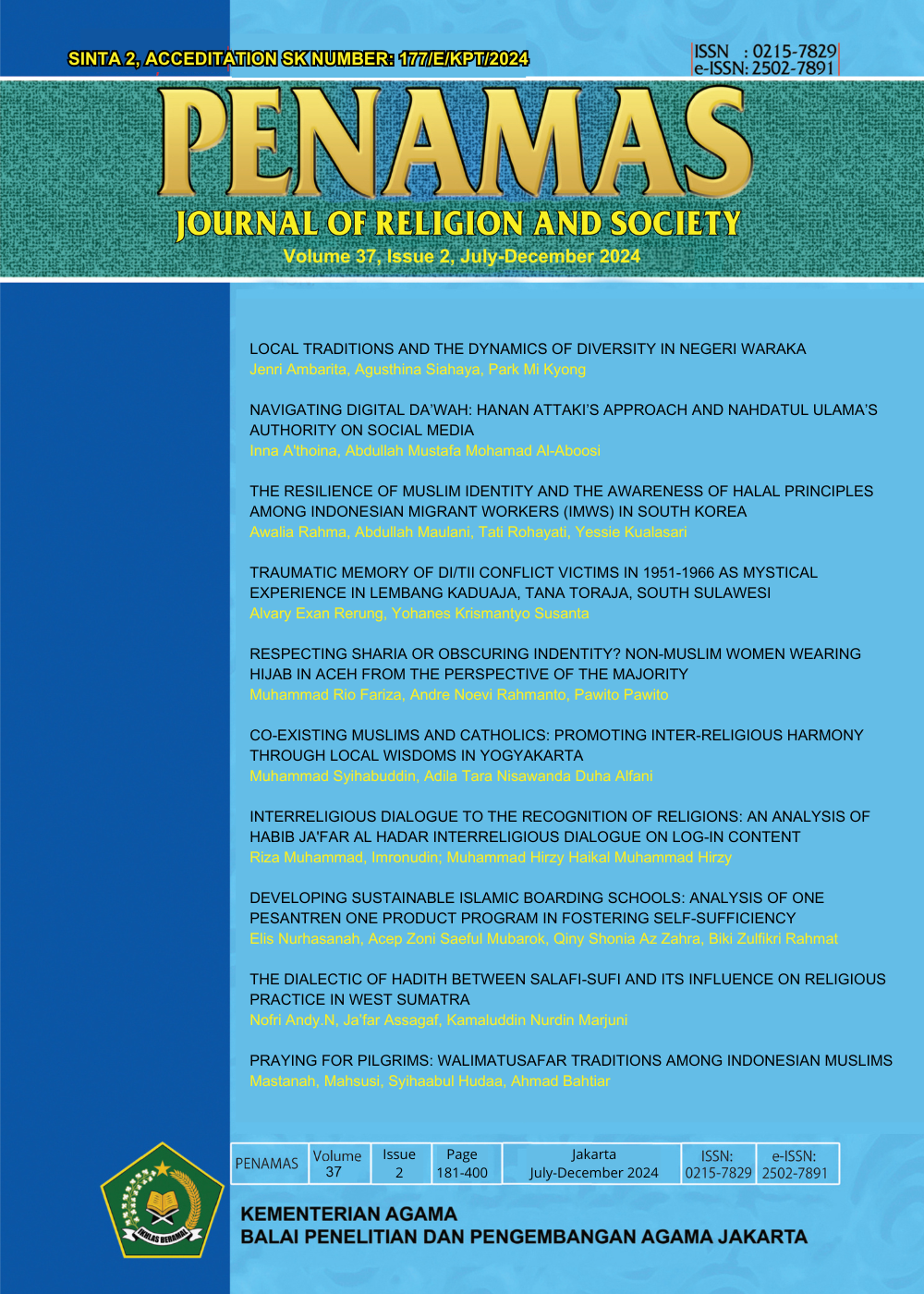LOCAL TRADITIONS AND THE DYNAMICS OF DIVERSITY IN NEGERI WARAKA
DOI:
https://doi.org/10.31330/penamas.v37i2.800Keywords:
religious diversity, social harmony, local tradition, Negeri Waraka, inter-faith toleranceAbstract
This research explores religious diversity and the value of harmony in the traditions of the Waraka community using a descriptive qualitative approach. The primary objective is to analyze how religious diversity is recognized in daily life and how values of harmony are promoted through their traditions. Data collection methods include in-depth interviews, direct observation, and document review with key informants such as the King of Waraka, his wife, religious leaders from Christianity, Catholicism, and Islam, as well as community members from various religions, including the King’s daughter-in-law from Manado. The collected data was analyzed using Miles and Huberman’s data analysis techniques. The findings show that the Waraka community practices interfaith tolerance through the joint construction of places of worship and shared religious celebrations. Traditions like “Ronda Kambing” and “Natsar Negeri” serve as concrete examples of interfaith interaction that strengthen social understanding. This research concludes that the religious harmony practices in Waraka can inspire the creation of inclusive and tolerant societies globally, with an emphasis on educational approaches and more structured interfaith dialogue.
References
Aditya, R., & Mayasari, I. (2022). The Implementation of Religious Moderation In Serang Municipal: Religious Harmony Forum Perspective. Penamas, 35(2). https://doi.org/10.31330/penamas.v35i2.626
Ahmad. (2021). Keragaman Masyarkat di Waraka.
Alam, S. (2023). Kerukunan dalam Beragama: Koeksistensi Antar Agama dalam Upacara Rambu Solo Tana Toraja. Sosioreligius, 8.
Almufadda, A. M. S., Fannani, B., Alturki, A. I. A., & Rohmah, S. (2020). Medina society: Lessons and their relevance in Indonesian education context. International Journal of Interdisciplinary Educational Studies, 16(1). https://doi.org/10.18848/2327-011X/CGP/V16I01/1-14
Arsal, T., Setyowati, D. L., & Hardati, P. (2023). The inheritance of local wisdom for maintaining peace in multicultural society. Journal of Aggression, Conflict and Peace Research, 15(2). https://doi.org/10.1108/JACPR-01-2022-0673
Atkinson, J. M. (2019). Gender and Islam in Southeast Asia: Women’s Rights Movements, Religious Resurgence, and Local Traditions ed. by Susanne Schröter. Indonesia, 108(1). https://doi.org/10.1353/ind.2019.0015
Blakemore, S. (2019). Faith-based Diplomacy and Interfaith Dialogue. Brill Research Perspectives in Diplomacy and Foreign Policy, 3(2). https://doi.org/10.1163/24056006-12340010
Boucher, F., Guérard de Latour, S., & Baycan-Herzog, E. (2023). Rethinking liberal multiculturalism: Foundations, practices and methodologies. Ethnicities, 23(4). https://doi.org/10.1177/14687968231151455
Dey, S. (2021). The relevance of Gandhi’s correlating principles of education in peace education. Journal of Peace Education, 18(3). https://doi.org/10.1080/17400201.2021.1989391
Dumitrescu, M. (2022). Metaphysical Foundations of the Idea of Tolerance in John Locke’s Philosophy. Postmodern Openings, 13(3). https://doi.org/10.18662/po/13.3/481
Essomba, M. À., Nadeu, M., & Tarrés Vallespí, A. (2023). Young Educators’ Voices on Interfaith Dialogue and Religious Diversity in Leisure Time Education: Towards an Effective Policy Framework and Training. Religions, 14(11). https://doi.org/10.3390/rel14111378
Fathorrahman. (2019). Inklusifisme di Tengah Masyarakat Multikultur: Kasus Tiga Komunitas Muslim di Bali. Penamas, 32(1).
Gianni, M. (2023). For a political conception of multicultural citizenship. Ethnicities, 23(4). https://doi.org/10.1177/14687968221149741
Hackett, C., Phillip, C., Marcin, S., & Vegard, S. (2015). The Future of World Religions : Population Growth Projections, 2010 . In The Future of World Religions: Population Growth Projections 2010 - 2050, PEW Research Center Report.
Haynes, J. (2019). Religion, education and security: The United Nations alliance of civilisations and global citizenship. Religions, 10(1). https://doi.org/10.3390/rel10010051
Hefner, R. W. (2011). Civil Islam: Muslims and democratization in Indonesia. In Civil Islam: Muslims and Democratization in Indonesia. https://doi.org/10.2307/3557788
Hutapea, R. H., & Iswanto. (2020). Pluralism and Inter-Religious Harmony in Diversity. Dilaog: Balitbang Kemenag, 43(76), 99–108. https://jurnaldialog.kemenag.go.id/index.php/dialog/article/view/363/190
Jagiełło-Szostak, A., & Kulska, J. (2020). The role of religious institutions in the process of reconciliation and peacebuilding – a case study of Bosnia and Herzegovina (Ahmići, Trusina and Bradina). Teorija in Praksa, 57(2).
Jahn, J., & Brühl, R. (2018). How Friedman’s View on Individual Freedom Relates to Stakeholder Theory and Social Contract Theory. Journal of Business Ethics, 153(1). https://doi.org/10.1007/s10551-016-3353-x
Khodaverdian, S. (2022). Islam and democracy. Kyklos, 75(4). https://doi.org/10.1111/kykl.12315
Kruja, G. (2022). Interfaith Harmony through Education System of Religious Communities. Religion and Education, 49(1). https://doi.org/10.1080/15507394.2021.2009305
Labrecque, C. A., & Grushcow, L. J. (2024). “Who is my Neighbour? Interfaith Dialogue and Theological Formation” (Responses). Journal of the Council for Research on Religion, 4(2). https://doi.org/10.26443/jcreor.v4i2.89
Lailossa, R. Y. . (2021). Wawancara dengan Bapak Raja Negeri Waraka “Kearifan Lokal Negeri Waraka.”
Malović, N., & Vujica, K. (2021). Multicultural society as a challenge for coexistence in Europe. Religions, 12(8). https://doi.org/10.3390/rel12080615
Matamaluku.com. (2021). Basudara Negeri Waraka, Bersama Antar Kubah Mesjid Al-Jihad Waraka. Matamaluku.Com. https://matamaluku.com/basudara-negeri-waraka-bersama-antar-kubah-mesjid-al-jihad-waraka/
Maurer, C., & Gellera, G. (2020). Contexts of religious tolerance: New perspectives from early modern Britain and beyond. In Global Intellectual History (Vol. 5, Issue 2). https://doi.org/10.1080/23801883.2019.1699869
Mokotso, R. I. (2024). Advancing interreligious education through the principles of SeMoshoeshoe. Theologia Viatorum, 48(1). https://doi.org/10.4102/tv.v48i1.215
Muslimah. (2021). Wawancara bersama Ibu Muslimah “Keragaman Masyarkat Waraka.”
Nalli, F., & Santori, P. (2023). The Economic Principle of Political Liberalism: A Comparison of Rawls and Sugden. Review of Political Economy, 35(2). https://doi.org/10.1080/09538259.2021.1951476
Nielsen, J. S. (2002). The Contribution of Interfaith Dialogue toward a Culture of Peace. American Journal of Islam and Society, 19(2). https://doi.org/10.35632/ajis.v19i2.1954
Pallavicini, Y. S. Y. (2016). Interfaith education: An Islamic perspective. International Review of Education, 62(4). https://doi.org/10.1007/s11159-016-9571-8
Pamir, E., Waheedi, A., & Habib, K. A. (2023). Some Aspects of Pashtun Culture. Randwick International of Social Science Journal, 4(3). https://doi.org/10.47175/rissj.v4i3.710
Pangalila, T., Rotty, V. N. J., & Rumbay, C. A. (2024). The diversity of interfaith and ethnic relationships of religious community in Indonesia. Verbum et Ecclesia, 45(1). https://doi.org/10.4102/ve.v45i1.2806
Parra-Ayala, A. F. (2023). Individual freedom against liberalism: Hegel’s nonliberal individualism. Southern Journal of Philosophy, 61(4). https://doi.org/10.1111/sjp.12538
Perveen, A. (2018). Facilitating multiple intelligences through multimodal learning analytics. Turkish Online Journal of Distance Education, 19(1), 18–30. https://doi.org/10.17718/tojde.382655
Regina. (2022). Wawancara bersama Ibu Regina “Kearifan Lokal di Negeri Waraka.”
Rini. (2022). Wawancara Bersama Ibu Rini “Tradisi Lokal Negeri Waraka.”
Ruslan, I. (2020). Toleransi Antar Umat Beragama Di Indonesia. Arjasa Pratama. https://books.google.co.id/books?hl=en&lr=&id=XEfrDwAAQBAJ&oi=fnd&pg=PR1&dq=Keragaman+yang+dimiliki+akan+menjadi+satu+kekuatan+besar+dalam+membangun+bangsa+jika+mampu+dikelola+dengan+maksimal.+Akan+tetapi,+keragaman+yang+ada+sangat+rentan+dengan+konflik+d
Rusydi, I., & Zolehah, S. (2018). Makna Kerukunan Antar Umat Beragama Dalam Konteks Keislaman Dan Keindonesian. Journal for Islamic Studies. https://doi.org/10.5281/zenodo.1161580
Siahaya, J., Roza, Y. M., Siddiq, A., Murdo, I. T., & Nafi, M. (2023). Interfaith Dialogue in the Context of Globalization: The Role of Religion in International Diplomacy. International Journal of Science and Society, 5(4). https://doi.org/10.54783/ijsoc.v5i4.856
Stuparich, E. (2022). Self-Orientalism at Europe’s Margins: Historical Imaginary, Ritual Practice, and Interfaith Dialogue in an Indo-Baltic Nāth Network. Religions of South Asia, 16(1). https://doi.org/10.1558/rosa.23306
Suparjo, S., Hanif, M., Dimas, I. S., Suwito, S., & Efendi, A. (2022). Inclusive religious education to develop religious tolerance among teenagers. Cypriot Journal of Educational Sciences, 17(8). https://doi.org/10.18844/cjes.v17i8.7135
Thameem, U. (2024). Muhammad Hamidullah’s Role in Interfaith Dialogue. Al-Risalah: Journal of Islamic Revealed Knowledge and Human Sciences (ARJIHS), 7(2). https://doi.org/10.31436/alrisalah.v7i2.459
Tskhadaia, G. (2021). The paradoxes of tolerance: A deconstructive view. Analiza i Egzystencja, 53. https://doi.org/10.18276/aie.2021.53-02
Wahyu Aji, Ziyah, & Mahwiyah. (2023). The Influence Of Science Dichotomy On Islamic Religious Education Curriculum. Amandemen: Journal of Learning, Teaching and Educational Studies, 1(1). https://doi.org/10.61166/amd.v1i1.2
William Wilson. (1999). Wilson’s Old Testament Word Studies. MacDonald Publishing.
Wordpress.com. (2021). Waraka, negeri / P. Seram – prov. Maluku. Wordpress.Com. https://sultansinindonesieblog.wordpress.com/maluku/waraka-negeri-p-seram-prov-maluku/
Downloads
Published
Issue
Section
License
Copyright (c) 2024 Penamas

This work is licensed under a Creative Commons Attribution-NonCommercial-ShareAlike 4.0 International License.








